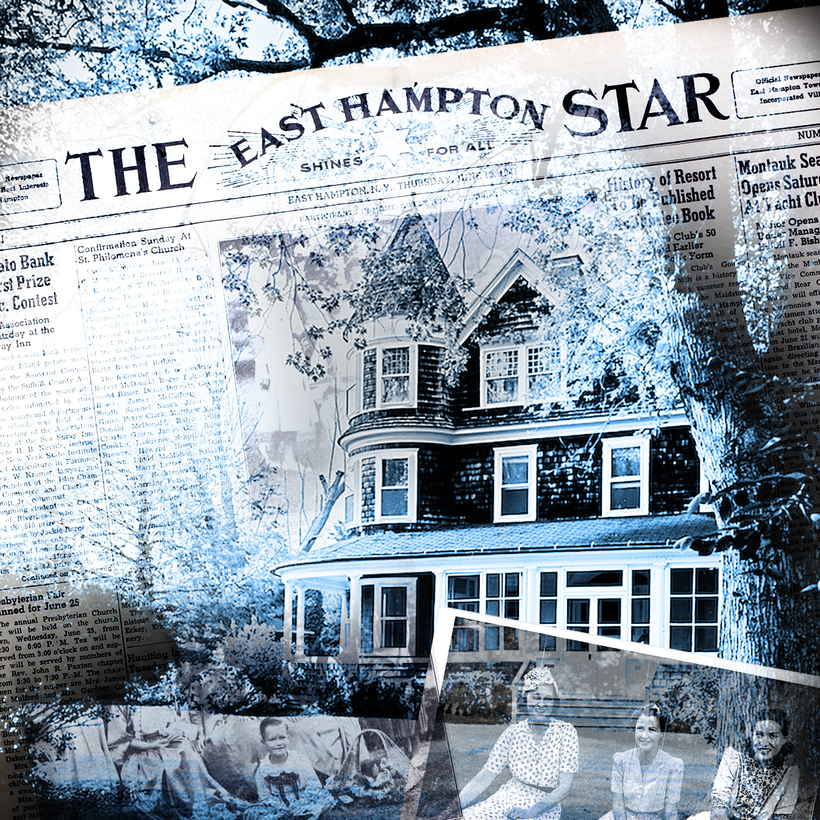On a Saturday morning in 2016, the summer after my sophomore year of college, I stepped off the Hampton Jitney, a roller bag and boyfriend in tow, for a weekend in East Hampton. Uncharacteristically, I decided we should walk the mile home, turning right at the Huntting Inn onto Huntting Lane, a picturesque street on which houses can sell for tens of millions of dollars. My boyfriend, a first-timer to the eastern tip of Long Island, bounded ahead between the hydrangeas and historic homes, then stopped.
The crumbling Victorian to our left, devoured by weeds and sloughing off shingles, looked like something out of a Hitchcock movie. I raised my phone to take a picture when suddenly a voice thundered from the house’s turret:
Nosy, nosy, nosy! Didn’t your mother ever teach you any manners?!
I shrieked. We ran. And as I looked behind me, I saw an old man in pajamas chasing us down the street with a rake.
My encounter with the Boo Radley of 30 Huntting Lane was not unique. He had appeared sporadically, and unnamed, in local newspapers for years. “The Huntting Lane man who in recent years, wielding a rake, has chased away tourists who have wandered onto his dilapidated property, took on a landscaper last Thursday,” The East Hampton Star reported in 2016. When a neighbor’s landscaper parked his truck in front of the house, “the man struck him with a cane through the open passenger window, screaming that he should get off his property.”
Other reported incidents include him threatening a gardener with a piece of aluminum siding for blowing leaves onto the street; chasing a man with a pole after he accidentally stepped onto his property, thinking it was abandoned; and throwing driveway gravel at a visitor who also assumed no one was living there. In January 2017, police reportedly visited the property in response to a report of what looked like blood in the snow by his front porch. The stains, the man told the officer, were from beet juice.
However, when I passed the house earlier this summer, I saw a dozen workmen sanding, scrubbing, and shingling the place—a sure sign of new ownership. Some sleuthing soon delivered a revelation: not only was the Rake Man of Huntting Lane dead; it turned out he was a Huntting.
The man struck him with a cane through the open passenger window, screaming that he should get off his property.
Edward Tyler Huntting Jr., known as Tyler, was born in 1934, the only child of Edward Tyler Huntting Sr., owner of the East Hampton Lumber & Coal Company, and Hilda Weber, a socialite and real-estate broker. The Hunttings’ roots in the area stretched back to 1696, when the Reverend Nathaniel Huntting became pastor of the First Presbyterian Church of East Hampton. The Huntting Inn, where the Palm Restaurant now serves up 22-ounce rib eyes, was originally built as a home for the reverend and his family.

The area’s transformation from small, bucolic town to bustling summer colony was in large part due to the Hunttings’ lumber-and-coal business, and by 1896, the family had built their Queen Anne–style home on the newly opened Huntting Lane, then a dirt road traveled by horse and buggy.
Mr. and Mrs. Edward T. Huntting were regulars in the society pages of The New York Times. A picture from 1940 shows Hilda Huntting sitting alongside the young Edith Bouvier Beale (“Little Edie,” as she was known, became another East Hampton recluse and was a subject of the 1975 documentary Grey Gardens). Hilda, who was remembered by a neighbor as “always immaculately dressed, with coiffed hair,” cashed in on the East End’s expansion that her family had helped foster by becoming a real-estate broker. Widowed in 1969, she spent the next few decades running the Hilda Huntting Agency out of her home, helping the land around her swell into what is commonly known as the Hamptons.
Her son, Tyler, led a less public existence. Beyond his storied ancestry and his parents’ social engagements, the clues to his life are sparse. In newspaper archives I could only find images of him as a boy. One shows him at age seven, posing as the groom at a “Tom Thumb wedding”—a pretend wedding between two young children put on for an adult audience—to benefit the Presbyterian church. Another shows him as a 12-year-old playing Prince Charming in the East Hampton Grade Chorus’s production of Cinderella.
He attended East Hampton public schools, graduated from Albright College, a small liberal-arts college in Pennsylvania, moved to San Francisco, married in 1969, and was divorced about three years later. When Hilda was diagnosed with Alzheimer’s, Tyler moved back from California to live with her until her death, in 2000.
The neighbors on Huntting Lane recalled that the property decayed in the years following. Most people left the hostile and unpredictable Tyler well alone. But the once beautiful house was becoming a blight amid Huntting Lane’s picturesque historic district. Rumor has it that several years ago, the village finally got through to Tyler about the state of his property, prompting him to call up Tom Strong Lawn and Home Care, whose eponymous owner sent Tom Strong Jr., his son, to help clean the place up. What began with lawn mowing and tree trimming seemingly evolved into grocery runs and social visits, and an unlikely friendship between Strong, who also works as an East Hampton Town police officer, and Huntting, a man 40 years his senior.
When Tyler Huntting died at a Southampton hospital, in January, many locals, including the village historian, were surprised to find out he was a Huntting. Even more surprising was his last will and testament, which bequeathed his home—estimated to be worth more than $4 million—and what was left of his family’s fortune to Thomas A. Strong Jr. (Strong did not respond to a request for comment.)
Richard Brockman, like other neighbors, is relieved by the rapid restoration of 30 Huntting Lane. Owner of the Woodhouse Playhouse, Brockman joined local efforts to establish the Huntting Lane Historic District, intended to “protect the character of the street” and “maintain the architectural integrity of the historic properties,” in the late 1990s. “I was always afraid that whoever owned [the house] was going to eventually die and sell it to someone who would tear it down,” Brockman told AIR MAIL. “That some McMansion would get built.”
But for once in East Hampton, that does not seem likely to happen. The house will soon be restored to its former glory, a parting gift to the neighborhood from the Rake Man of Huntting Lane.
Carrie Monahan is a Brooklyn-based writer and producer


